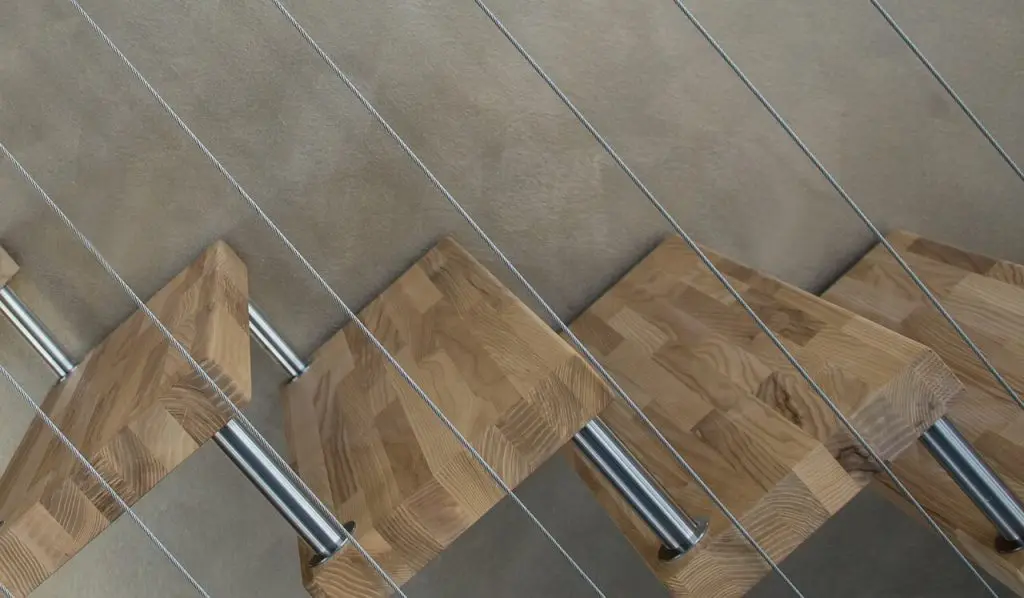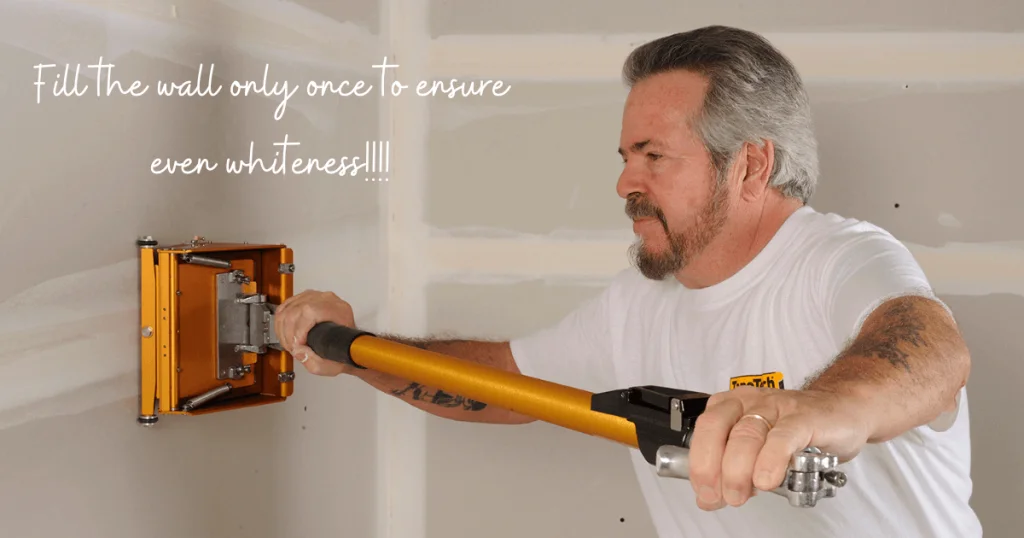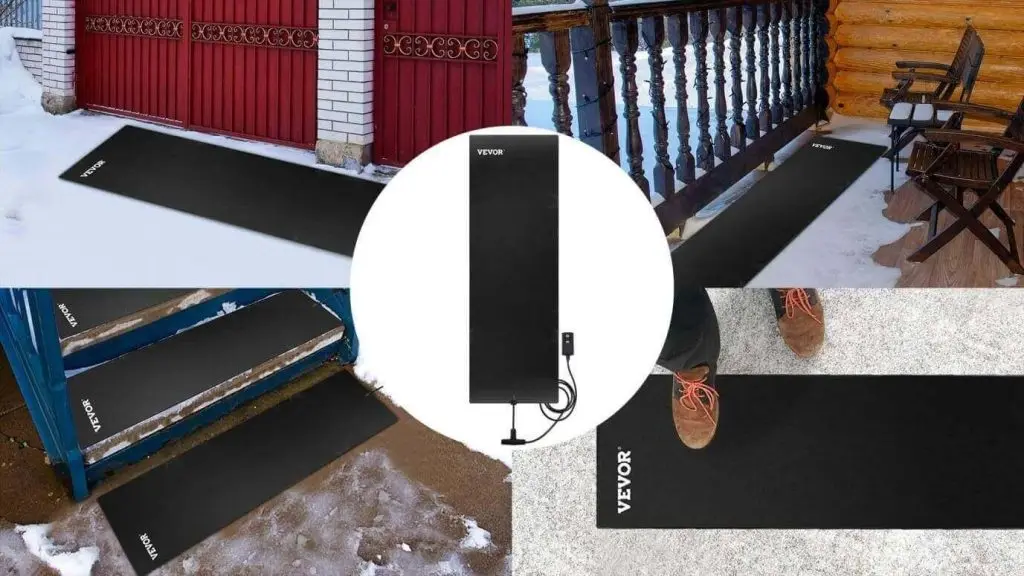When you look at decks, balconies and outdoor stairs, the first thing that you’ll notice is the obstructed view thanks to the large beams used to support them. As a result, there’s little thrill to the aesthetic quality of contemporary decks and balconies. What’s more is that these obstructions are quite pricey to maintain. But that’s where cable railing marks a difference.
Unlike contemporary support systems, cable railings are designed for ease, low maintenance, practicality, improved aesthetics and natural lighting. Thanks to their easy-to-install design, cable railing are fast replacing traditional railings. But then, cable railing cost is the “big bad” that makes people hesitant.
Besides the cost of cable railing itself, it’s important to know the cost to install cable railing. In this article, you’ll find the answer to how much does cable railing cost. You’ll also get to know the lowest cable railing cost per foot.
Sneak peek; it’s about $40, but you can find the full range below.
Table of contents
How Much Does Cable Railing Cost Per Foot?
Cable railing cost per linear foot is usually determined by three factors; quality and quantity of materials, project complexity, and labor. Generally though, the cost of cable railing per foot ranges between $40 to $285.
Let’s dig a little deeper.
Cost of Cables For Railing
The cost of cable railing is majorly determined by the quality and quantity of cables to be used for railing. There are two main types of cables for railing; galvanized carbon steel wire, and stainless steel cable. These cables have different properties which determine their market prices.
Let’s talk about each one.
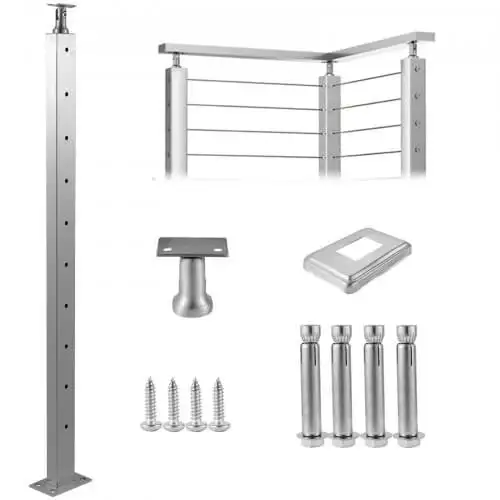
Galvanized Carbon Steel Wire
This type of cable is flexible and affordable compared to stainless steel cables. It’s the ideal option for low cost cable railing. It costs around $0.25 to $1 per foot depending on the wire’s thickness. Thin gauged galvanized carbon steel wires cost around $0.1 to $0.25 per foot. Medium gauge of this cable costs around $0.25 to $0.5 per foot. Thicker gauge costs between $0.5 to $1.
Although galvanized carbon steel wire is a cheaper option, its zinc coating is susceptible to rust which ruins its appeal. It also has a weaker strength compared to stainless steel cable. As such, it cannot handle much tension or load when used in installing cable railing.
Up next, we have the stainless steel cable.
Stainless Steel Cable
Stainless steel cable is the popular choice for cable railing. Thanks to its steel core, it has greater strength and durability. It is resistant to rust and harsh weather conditions, and is ideal for outdoor applications. Though it’s more expensive than galvanized carbon steel wire, it’s still cost-efficient thanks to its durability and low maintenance nature.
On the pricing side, stainless steel cable is available in different grades which influences its price. The grades are determined by the wire’s thickness. Starting with the “Thin 304 ⅛ inch grade”, it costs around $0.5 to $1 per foot. The popular choice – medium 304 ¼ inch grade costs between $1 to $2 per foot. Marine (316) grade costs above $2 per foot.
For most cable railing installation, medium 304 ¼ inch grade stainless steel cables are perfect. Standing out with discount offers, VEVOR’s stainless steel cables are available in both medium and marine grades. With $85, you can purchase up to 500ft of medium 304 ¼ inch grade cable for your cable railing project.
VEVOR’s 304 ¼ inch grade stainless steel cables has a holding strength of up to 6400 lbs which means it can handle the weight of an elephant. It’s perfect not just for cable railings but other heavy-duty projects as well.
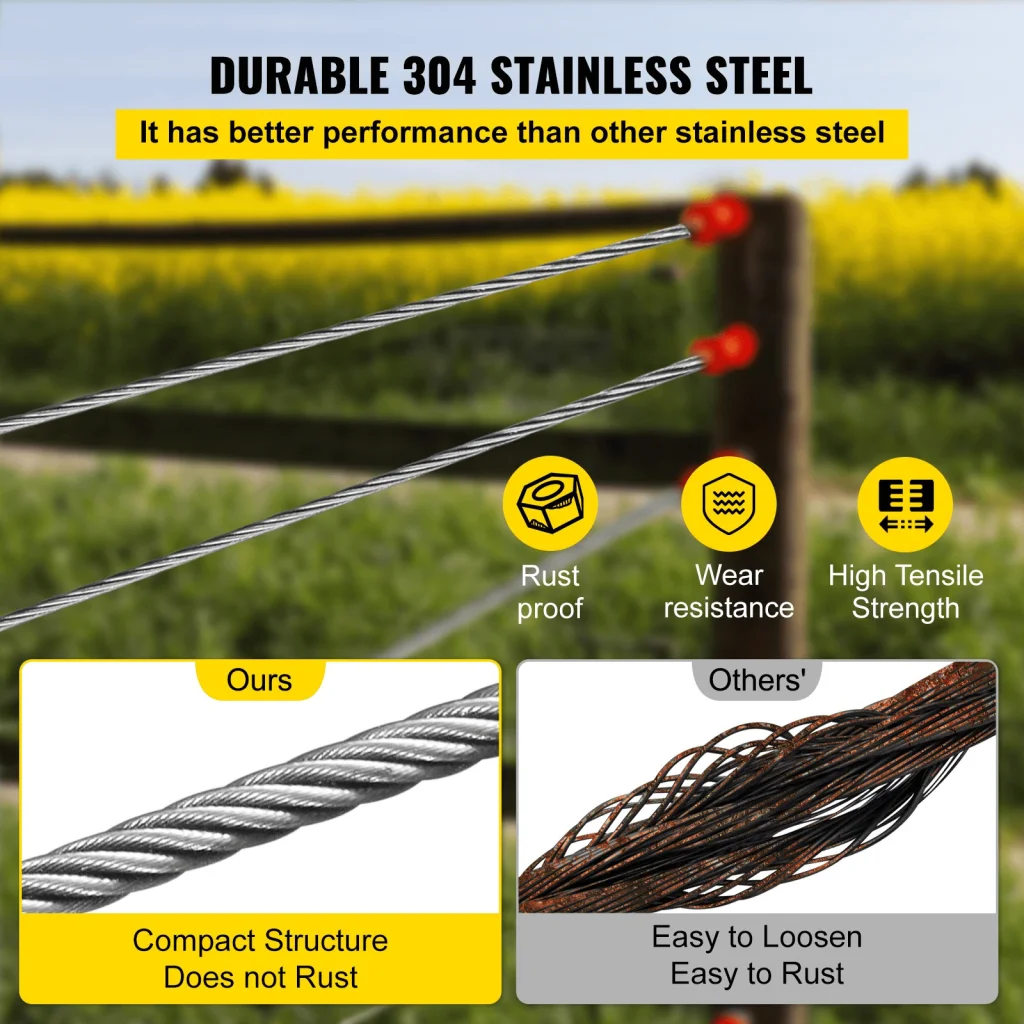
In addition to cables, it’s also vital to ascertain the price of handrails and posts for cable railing.
Prices of Handrail and Posts for Cable Railing
Besides the cables, handrails and posts are essential materials that determine cable railing cost. Handrails provide solid grip when navigating cable railing stairs, and the posts are what hold the cables railings. Generally, their cost is determined by the quality and quantity of their materials.
Let’s see the factors that influence the cost of handrails and posts.
Factors Determining Cost of Handrails and Posts
Handrails and posts are typically made of wood or metal. Wooden handrails and posts typically require higher maintenance compared to metal ones. But they’re cheaper than metal handrails and posts.
Generally, you’ll find wooden handrails between $20 to $50 per linear foot, and posts between $30 to $80 each. But metal handrails cost between $30 to $100 per linear foot, and metal posts between $50 to $200 each.
The major factor that determines the cost of handrails and posts is the types. These include:
- Squared stainless steel posts and handrails,
- Round stainless steel posts and handrails,
- Aluminum posts and handrails,
- Wooden posts and handrails, v
- Vinyl and composite posts and handrails
Other factors that drive up price include:
- Quantity; some projects require more handrails and posts which costs more. However, you may find discount offers.
- The height and strength of the handrails and posts also drive up price.
- Posts with pre-drilled cable holes typically cost more than regular posts.
Different types draw different prices. Let’s see.
Cost of Handrails and Posts
Factoring in the types of handrails and posts in the market, the price ranges from $20 to $200. The quality of the material used in making each type of handrail and post determines its prices.
Let’s check them out.
Squared Stainless Steel Posts And Handrails
These are the toughest posts and handrails in the market. The popular 304 grade posts start around $50 to $100 per post while handrails cost about $40 to $60 per linear foot.
Up next is the round stainless steel.
Round Stainless Steel Posts And Handrails
Main of the same solid material as the squared stainless steel posts and handrails, round stainless steel posts and handrails stand out due to their smooth curves and soothing appearance. Their 304 grade posts cost around $50 to $100 each, and their handrails cost around $40 to $60 per linear foot.
If it’s not steel, it’s aluminum.
Aluminum Posts And Handrails
These are lightweight, low maintenance and rust-resistant posts and handrails that are cheaper than stainless steel. Aluminum posts cost about $40 to $60, while the handrails cost around $30 to $50 per linear foot.
Now, let’s talk about wood posts and handrails.
Wood Posts And Handrails
Wooden posts and handrails have a natural outlook which makes them preferable. They cost between $20 to $50 per linear foot for handrails, and between $30 to $80 for posts. They require periodic sealing against harsh weather conditions.
A more durable alternative to wood is vinyl and composite.
Vinyl And Composite Posts And Handrails (50)
Vinyl and composite posts and handrails are low-maintenance options that are more durable than wood. They cost between $32 to $74 per linear foot for handrails, and $60 to $100 per post.
Let’s see how much labor would cost to install cable railing.
Labor Cost To Install Cable Railing
Installing cable railing has a lot of benefits. Although they’re easy to install, sometimes it’s better to get a professional to do the job. But then, hiring an expert means you’ll have to deal with potentially high cable railing installation costs.
The cost of hiring a contractor is typically determined by four factors:
- Project complexity; simple designs are easier to install and also cheaper. Any other twists and turns will cost more.
- Project type; the cost to install cable deck railing is simpler and cheaper compared to the cost to install stair cable railing.
- Location; labor rates vary depending on location and the availability of experts in the area.
- Materials; while it may be easy to carry out a DIY installation using thinner cables and simpler designs, thicker cables require costly specialized tools and skills.
Most contractors offer quotes based on the scope of work – which will consider the factors above. But, before you choose a contractor, consider these tips:
- Get quotes from multiple contractors and weigh your options
- Be as detailed as possible to get a full quote and avoid extra charges.
- Ensure that the quote is detailed, and also ask about hidden charges
- Try your hands on online cable railing calculators to get a fair price range for your project.
Read the next part if you’re considering a deck cable railing.
How Much Does Deck Cable Railing Cost?

Just like generic cable railing installation cost varies, cable deck railing cost also varies. The average cost of cable railing is about $200. Generally, a deck cable railing costs between $100 to $300 per linear foot.
This price range covers the costs of posts, handrails, cables, and other essential components. Note that the complexity of the project and the quality and quantity of the materials still determine the final cost of a deck cable railing.
Let’s see if cable stair railing costs a little more.
How Much Does Cable Stair Railing Cost?
Cable stair railing cost just as much as deck cable railings, but with a slight rise in price. Cable stair railing are a little more expensive due to their complex design nature.
Unlike deck cable railings that sport simple designs with fewer curves, angles and levels, cable stair railing cost more as they require more materials to cover their complex design area. The cost of cable stair railing ranges between $100 to $350.
In addition to these costs, there are hidden costs to watch out for. Find out how to avoid them.
Tips for Budgeting Cable Railing: How to Avoid Hidden Costs
Price scares and hidden costs often prevent people from executing their cable railing projects. But the secret to avoiding hidden costs lies in being detailed. Here are some tips to help with budgeting and avoiding hidden costs:
- Try a cable railing cost comparison from multiple contractors. This will help you figure out the average cost of cable railing projects which you can plan with.
- Be detailed in listing out the requirements of your project, and add a price range per item.
- When buying your cable railing components, it’s better to have more than enough. Most times, you’ll get discounts for bulk purchases rather than unit purchases. The same applies to your budget – add a few more dollars for miscellaneous needs.
- The more complex your design, the costlier it will be. Simplify your design as much as possible.
- Factor in infill measurements, corners, stairways, runways, and curves into your budget.
- Be detailed in your measurements, and always double-check for accuracy when given a quote.
And there you have it.
Key Takeaways
- Cable railing cost varies depending on the project type, materials, and labor. But there’s always a range for the type of project you’re working on.
- When shopping for cable railing components, always check multiple stores for price differences. VEVOR offers great cable railing components at great prices.
- Rather than buying several installation tools, it’s cost-effective to simply hire a professional.
- Always ask for detailed quotes from multiple contractors, and check reviews before choosing a contractor. You’ll find five-star rated cable railing components on VEVOR.
Any questions? Check out the FAQs below.
FAQS About The Cost of Cable Railing
Is cable railing easy to maintain?
Yes, cable railing is easy to maintain. By design, they’re low maintenance and only need occasional cleaning. However, be sure to periodically check the tension in the cables.
How many posts will I need for my cable railing?
The amount of posts you will need for your cable railing depends on five things; project scope, length of railings, preferred tension and deflection level, local regulations, and desired outlook. You can use an online cable railing calculator to get an estimate.
How much cable will I need for my railing?
There’s no specific amount of cables to use for railing. You’ll have to factor in the type of design, possible turns, amount of cable levels, spacing between the posts, and overall railing length to figure out how much cable you will need.

